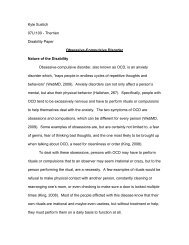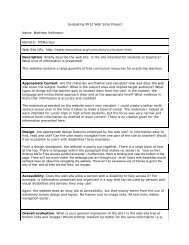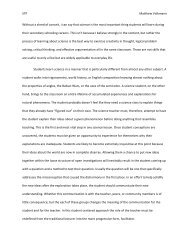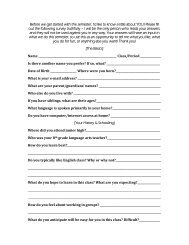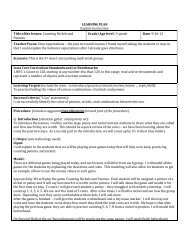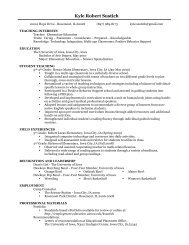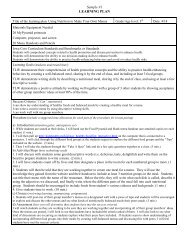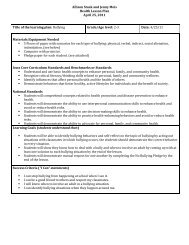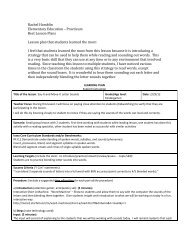Writing child study - Employment
Writing child study - Employment
Writing child study - Employment
You also want an ePaper? Increase the reach of your titles
YUMPU automatically turns print PDFs into web optimized ePapers that Google loves.
I also noticed that when I have Nadjib reread his work<br />
out loud to me and when he comes across a part that is<br />
syntactically incorrect; he will pause for a fraction of a<br />
second and read not what was on the page, but how it<br />
should have read.<br />
take out the last two sentences that didn’t play into what his<br />
story was about. All in all, it helped him think about his<br />
writing on the whole text level. It also got him more<br />
familiar with the writing process as he said he had never<br />
been through it before.<br />
One of the questions Ray poses is “When she reads what<br />
she’s written does she read it so it sounds like literature?”<br />
(2004, p. 131). This question got me thinking about when<br />
reading aloud to me and Nadjib comes across a part of his<br />
writing that is syntactically incorrect, he will pause and read<br />
what he should have written. I think this is him editing his<br />
work unconsciously. He knows it’s written incorrectly but<br />
doesn’t make an effort to go and change it afterwards. He<br />
also did this before I gave him the print out of the writing<br />
process so it makes be believe it’s tied into him not seeing<br />
an end point or not seeing a need to change anything<br />
because he wasn’t seeing a clear audience.<br />
Recommendations<br />
My recommendation for helping him spell words right that he is spelling as they sound I would do lessons that<br />
concentrate on double vowels like “ea” and “ai” because he struggles with words like speak, eat, leaves, chair, and<br />
field. I know he understand the silent “e” rule because he spells words that use that rule correctly and even puts an<br />
extra “e” on the end of some words that he is hesitant on spelling like lion. In one piece of writing he uses the<br />
tranpositional spelling first, then spells it correctly, and then puts an “e” on the end. I would leave his transpositional<br />
spelling strategy alone because he is so close to spelling it right with all the correct letters but isn’t sure where they go.<br />
My assumption is confirmed by Oglan when he says, “When <strong>child</strong>ren spell words with all the correct letters present<br />
but in the wrong order, it indicates that the <strong>child</strong> is about to internalize the correct spelling” (2000, p. 38).<br />
Since I haven’t seen Nadjib use a pronoun at all with my time working with him it leads me to believe that he doesn’t<br />
know what they are. My recommendation would be to present a mini lesson on pronouns, what they are, and how he<br />
can use them. I think this would benefit him and strengthen his writing greatly.<br />
Nadjib knows that a capital letter and punctuation is what constitutes a sentence in English, but he struggles with<br />
knowing how and when to use them. This is very challenging to define easily for students. I think the easiest way to<br />
help him with including these in his writing would be to practice writing sentences. Single sentences and thoughts.<br />
<strong>Writing</strong> several complete thoughts that are unrelated and concentrating on using a capital letter and punctuation I think<br />
will help him understand when to include a capital letter and punctuation. <strong>Writing</strong> unrelated sentences doesn’t force<br />
him to make a connection between the sentences and that might potentially be where he gets confused. A step beyond<br />
writing unconnected sentences could be to have him write a story about a wordless picture book. The pages could in<br />
theory indicate when to use punctuation but encouraging him to make the pages and sentences into a story could help<br />
him see how to connect those sentences.<br />
For the whole text level of his writing instead of asking him if he thought there was anything in his story he didn’t<br />
think should be in there when I was trying to get him to realize that the last two sentences didn’t make sense with his<br />
story I think it would have been a lot more beneficial if I would have asked why he included those sentences. Ray<br />
claims, “We believe that being asked again and again to explain their writing teaches them to think about how and<br />
why they are writing things in certain ways” (2004, p. 132). I did actually ask him the why and how questions<br />
sometimes but I never really got an answer out of him other than “I don’t know” so I kind of shied away from it. After<br />
reading Ray, I know I was on the right path but I needed to follow through with it even though I wasn’t getting<br />
answers because he states, “…we know that at first they don’t have much to say in response, but over time they’ll<br />
come to see themselves as people who should be able to answer that question, and they’ll grab hold of their decision<br />
making more specifically” (2004, p. 132).<br />
Since he is a visual learner I should have him draw a picture and then write a story. Giving him something to look at<br />
will help him see the story in his head and I think by doing this, his stories would have better results and detail.<br />
Another option would be to use a spinoff of Steeds idea of a descriptive report. This has two benefits for him. One, it<br />
would challenge him to write something other than something he has personal experience with (which is what he<br />
basically only wants to write about) and two, it would allow him to see visually what he is writing about. Steed (2002)





